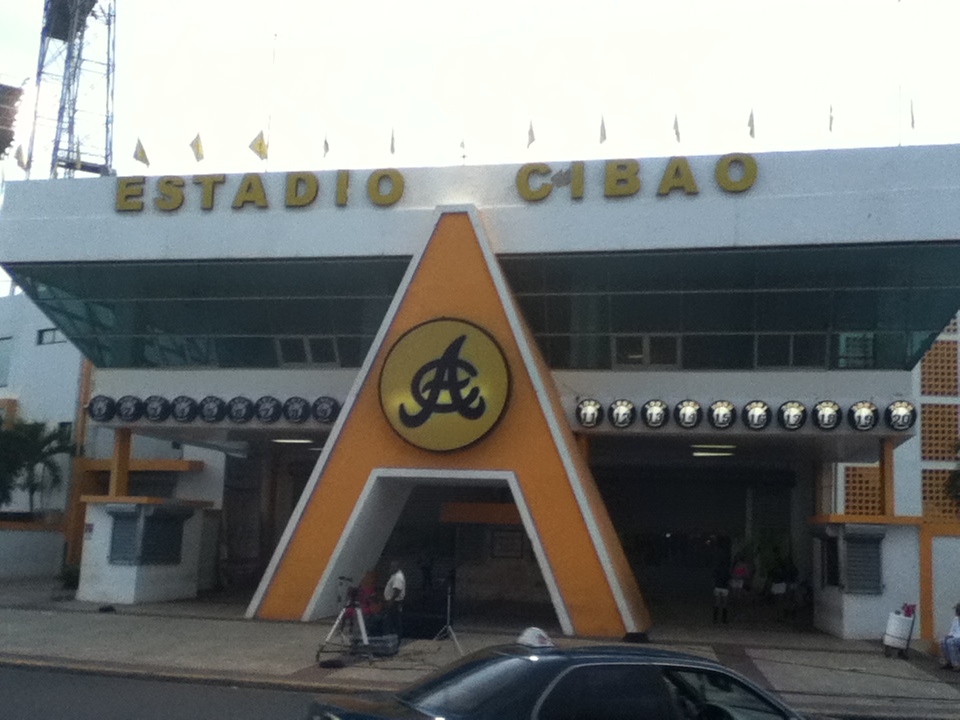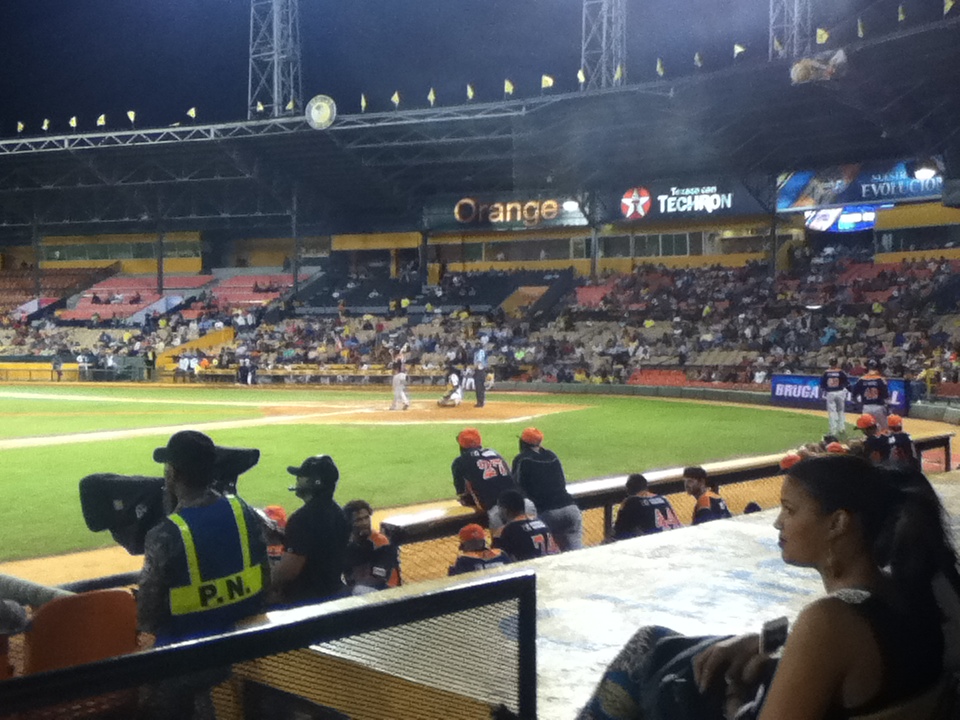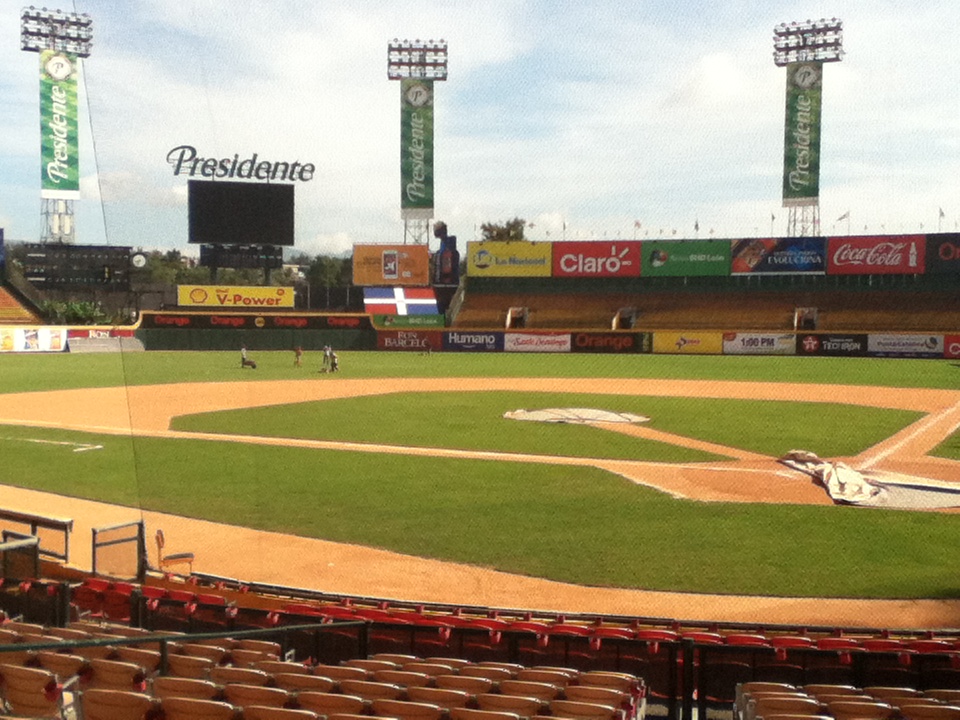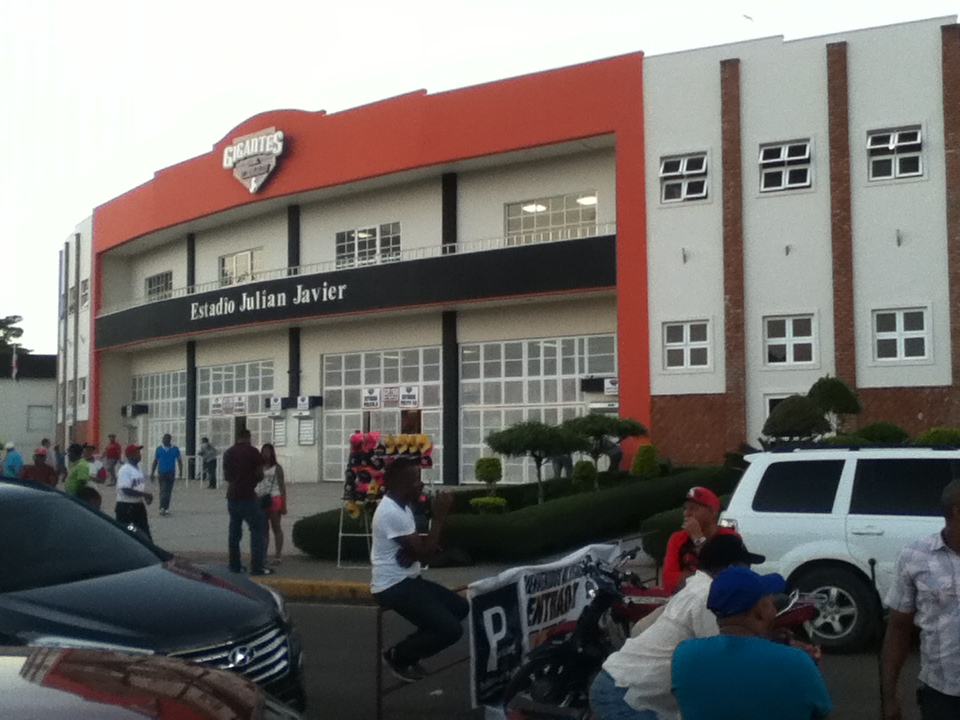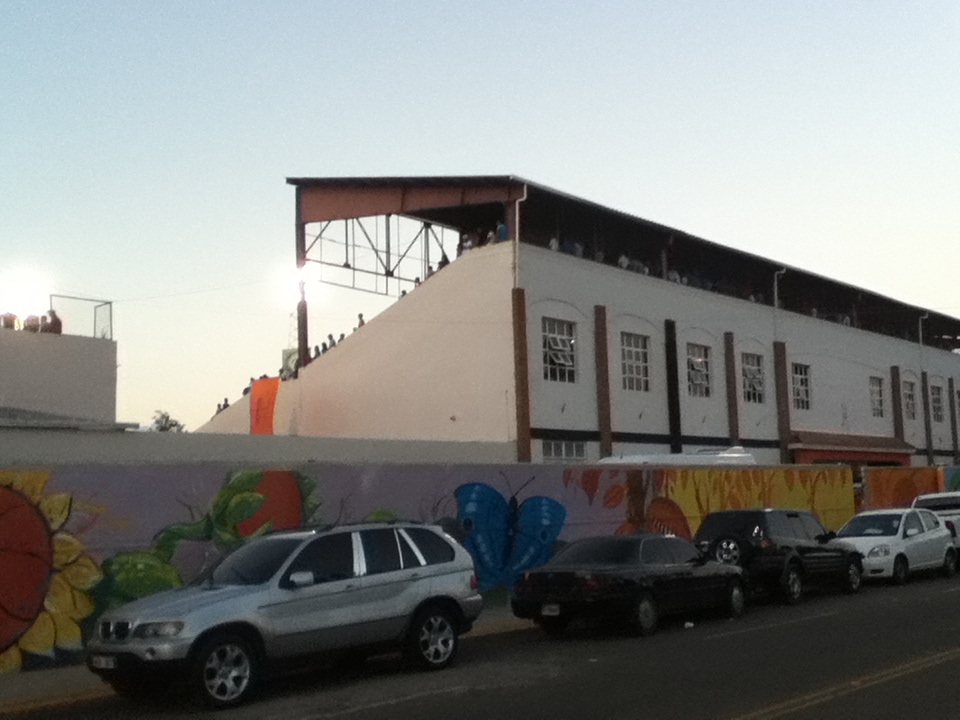Editor’s Note: Mark Cryan, former MiLB general manager and Ballpark Digest contributing editor, is releasing a series on his travels to the ballparks of the Dominican Winter League. What follows is part three of his three-part installment.
The World Series is over, the weather is turning colder, and baseball fans, like Rogers Hornsby said, are preparing to “stare out the window and wait for spring.” But, you don’t have to wait until spring training to feed your baseball addiction. The Dominican Winter League is just a short plane ride away!
There is no place in the world where baseball courses through the veins of the nation like the Dominican Republic. This tiny, impoverished country of just over 10 million people produces roughly 10% of all the players in the major leagues, and has sent hundreds of players to the U.S. since the first Dominican player, Ozzie Virgil, made his Major League debut in 1956. The D.R.’s exports include stars like Robinson Cano, Pedro Martinez, David Ortiz, Manny Ramirez, Juan Marichal, and Vladimir Guerrero.
And, you never know who will run into while you’re there. I’ve run into Orioles pitcher Ubaldo Jiminez at the airport luggage carrousel, dropped in on the Mets Bartolo Colon at his complex, talked baseball with former All-Star Julio Franco in Consuelo, seen Hall-of-Famer Pedro Martinez in parades in Santiago AND Santo Domingo, traded baseball riddles with the legendary Ozzie Virgil, played dominos with the Marlin’s Marcell Ozuna, and seen Manny Ramirez play for Santiago.
I have had the good fortune to visit the Dominican Republic six times over the last three years, including several visits during the winter, when the Liga Dominicana (LIDOM for short), was in full swing. Known to American baseball people as the Dominican Winter League, this is the “big leagues” for Dominican fans and is a place where their hometown heroes play for the love of the game, their country, and their hometowns during November, December and January. While the play on the field is below major league caliber, the passion and joy that the players and fans bring to the game make it a fan experience like nothing else I have ever experienced.
This league is not to be confused with the Dominican Summer League (DSL). The DSL is a Rookie-level minor league composed of teams of teenage Dominicans, Venezuelans and other Latin players that competes during June, July and August. Those games are played in the Dominican complexes operated by Major League Baseball teams in front of coaches and scouts, much like the Arizona Rookie League or the Gulf Coast League.
In the series, I have described each of the five stadiums that host games in the Liga Dominicana, starting with Estadio Quisqueya Juan Marichal in part one, followed by Estadio Tetelo Vargas and Estadio Francisco Michelli in part two. What follows is part three, featuring visits to Estadio Cibao in Santiago and Estadio Julian Javier in San Francisco De Marcoris. Near the end of the article, fans of the legendary “Big Sexy,” aka Cy Young Award Winner and ageless innings-eater Bartolo Colon, will find a write-up of Colon’s own stadium. At the very end of the article, you will also find some useful links that will help you if you plan a visit to the D.R. or just to follow your favorite Dominican prospects during the winter league season.
LIGA DOMINICANA
With six teams, including two in the capital city of Santo Domingo, the Dominican Winter League no longer features many big stars like it once did; the players here are primarily minor leaguers who play in Single A, Double A and Triple A, some older players showcasing themselves for a new deal, and a few established major leaguers. The big league teams generally don’t want to risk an injury to their established major league players by playing in the winter. Nonetheless, this is the highest level of baseball in the Dominican, the wellspring from which the richest stream of baseball talent in the world flows. When this great baseball is combined with the passion and joy of the Dominican fans, the beautiful beaches, and the wonderful welcoming people, you have a truly special place that every serious baseball fan should experience at least once in their lives.
SANTIAGO
Stadium: Estadio Cibao
Year: 1958
Team: Aguilas Cibaenos (1937)
Tickets were less of a concern in Santiago when we were there. The stadium is enormous, with a capacity of over 18,000 people, and the fans (and the city itself) seem to be more reserved than Santo Domingo. The Aguilas Cibaeños (the Eagles of Cibao, which is the region) were on the verge of elimination, but this “must-win” game for the Aguilas was only attended by about 1,500 people.
The Estadio Cibao opened in 1958, and it was nearly identical to the ballpark in San Pedro when it was built, but it underwent a major renovation in 1973-74. The bleachers down the foul lines are now connected with the main grandstand, creating a single huge grandstand. Bleachers that encircle the outfield were also added.
In addition to serving as the home of the Aguilas, this stadium hosted the Caribbean Series in 2008, and there is a sort of monument to that event outside the front gates. An enormous life-like statue of an Eagle stands guard over the main entrance, and makes for a great photo op.
As the largest baseball stadium in the country, the stadium has much more of a “big city” feel than the other stadiums in the LIDOM. It reminded me of a 70’s era Triple A stadium or a 50’s big league stadium, with seating all the way around the field, and lots of black and gold. I was reminded of a Pirates game in the old Riverfront Stadium, and this is not a coincidence. Back during the era when Dominican teams had working agreements with American big league teams, the Aguilas had a long relationship with the Pirates, from whom they draw their jersey lettering font and color scheme.
Tickets in Santiago were a bit more expensive, about $600 pesos for seats about 30 rows up behind home plate. The operation in Santiago was more formal, and despite the smallish crowd, it was enough to be respectable. A visit to Santiago in 2015 included the chance to see Manny Ramirez play again, which was a treat, although he was wearing short hair instead of dreads, and number 42 instead of 99. Manny didn’t play winter ball last year, but I still hold out hope he’ll put the uniform back on. The Aguilas have also been managed recently by former AL MVP Miguel Tejada.
The beers were cheap, just 65 pesos each (about $1.50), and there was a female vendor in each section who danced between innings. While I usually try to eat “local food” at the ballparks in the D.R. , I bought a couple hot dogs in Santiago from a very hard-working vendor. The business operation in Santiago is very efficient, with lots of vendors walking the stands, and largely as a result of the stadium, seems more like major league operation.
SAN FRANCISCO DE MACORIS
Stadium: Estadio Julian Javier
Year: 1975
Team: Los Gigantes (1996)
In a smaller, more rural community in the same region as Santiago is the town of San Francisco de Macoris. Amid rolling hills and farms, you find Julian Javier Stadium, the home of the Gigantes del Cibao, or Giants (of course!) of Cibao (Cibao is the prime farming region of the country, which includes Santiago and San Francisco). Their home stadium, like the town, is very tidy and well cared for, and it’s located in a nice multi-sport park. The parking lots had rows of cars, the backdrop behind the stadium was trees and some bits of the mountains, and the whole thing had a more US minor-league feel than any of the other ballparks in the D.R.
The stadium is named for the long-time Cardinals second-baseman who grew up in San Francisco. The night we attended, the main grandstand was sold out, so we purchased tickets in the first base bleachers, which were big and perhaps 2/3 full. The idea of a group of gringos sitting in the bleachers seemed fairly novel to everyone, including the fans and the team staff. The stadium, built in 1975 and extensively renovated in 2013, has a capacity of 12,000. The game we saw featured a pretty tame crowd, compared with what we saw in San Pedro, and this is in keeping with what we’ve seen of the rest of the Cibao Valley; it is neater, more prosperous and more “buttoned up” than Santo Domingo and the south coast.
There were no dancers or mascot, and the overall operation was very staid; no screaming PA man, lots of security that seemed organized, and a very limited concessions menu. A tiny personal pizza for 150 pesos was decent, and the vendors were identified by shirts that said “Venderos Authorizado.” Beer was just 75 pesos, although you had to trek down into the concourse to get it.
The stadium itself is mostly white painted concrete, and it is another near clone of the stadiums in San Pedro or La Romana, except the main grandstand is a bit smaller, and the bleachers are much larger and have a roof over the top portion. This was another place where we sat in the bleachers, and, again, we seemed to the only foreign fans in the park, and were regarded as a novelty by the local fans. Several introduced themselves, and a pair of vendors seemed to be serving our group almost exclusively. This is the most out-of-the-way city in the league, but it can be done as a day trip out of either Santiago or Santo Domingo.
WHERE TO STAY, EAT, AND PLAY Visiting Santiago
If you leave the friendly confines of the south coast and head to Santiago, you will see the terrain change as mountains rise in front of you and rural settlements and trees stretch as far as the eye can see. About mid-way between Santo Domingo and Santiago, there is a favorite stopping point called “Typico Bonao,” which is actually a well-known pair of restaurants on opposite sides of the main highway. The goat (chivo) was delicious. The service was friendly, but very, very slow (as previously mentioned, life moves at a leisurely pace in the DR), so allow at least an hour for a meal here.
Santiago de Los Caballeros; A City of Gentlemen
Formally known as Santiago de Los Caballeros, or Santiago of the Gentlemen, this is a city that takes itself more seriously that Santo Domingo. Drivers are more aggressive, and more likely to use their horns in anger and the press in close at a merge. It’s also clearly more prosperous, with many more sidewalks, curbs, landscaping and more modern looking businesses. Santiago is also a great place to visit a Zona Franca, or free trade zone, one of which includes the La Aurora cigar factory, an actual working cigar producer with regular guided tours and good discounts in the factory store afterwards.
If you are visiting downtown Santiago, Hodelpa Centro Plaza is a nice, modern hotel with the benefit/drawback (you pick) of having a casino in the first floor. For strolling the city, the Calle del Sol is a great starting point for walking the downtown, with a nice selection of restaurants featuring open air seating, and a good nightlife spot as well. The Fortaleza San Luis figures prominently in the city and country’s history, and the Monument to the Heroes of the Restoration is an impressive sight, particularly at night, high on the city’s highest hill.
Other Attractions in the Cibao Valley
When you are in Santiago, it’s worth visiting 27 Waterfalls, or “Veintisiete Charcos.” This is considered a “must-do” in this part of the country for travelers seeking adventure activities. We didn’t know much more than that before we arrived, but we were greeted by a nice little visitor’s area with an an open-air restaurant, a bathroom and shower building, and an equipment area. We were outfitted in helmets and life vests, as well as water shoes that looked like something a 70-year-old Shriner would wear. We were assigned to a team of guides, who were friendly and did a good job looking after our group, and making this outing as safe as possible.
There were 27 waterfalls, although some would be better classed as water slides, and a few were just short hops down the stream bed. But, some were leaps or slides from dizzying heights. It was a great, fun experience, although this activity is not for anyone who isn’t physically able, or who can’t swim!
A Hidden Gem; Estadio Bartolo Colón
On the way to 27 Waterfalls, we had seen a set of ballpark lights on a hill above the road in a small town called Alta Mira. When we drove up the hill, we found a big set of rolling gates guarding a beautiful small concrete stadium painted yellow, with a colorful painting of the Virgin Mary flanked by several paintings of Bartolo Colón in the uniforms of his various Major League teams.
We were soon receiving a guided tour from Colón himself, who is running an academy in this complex. The dorm building featured a beautiful open-air lounge on the roof. The other building in the complex housed Bartolo’s many cars and an impressive collection of game-worn jerseys on the walls, including Jim Thome, Ichiro, A-Rod and more.
We were also treated to a tour of a sort of Bartolo Colón museum. It was nicely done, and he had a staffer who handled the English speaking parts. There was also a flier we picked up for a “Bartolo Colón Experience” type of group program which includes the museum, a tour, and a chance to get on the field and play a little ball, and this bears investigating for anyone planning a group visit to this part of the DR.
Driving in the D.R.
The conventional wisdom in the baseball community is that Americans should NOT drive in the D.R. Statistically, the D.R. is one of the most dangerous places in the world to drive, and there seems to be little regard for traffic laws and stop signs, particularly in the south of the country. There is also an ever-present chance of being shaken down by the poorly-paid police for a bribe to get out of a non-existent traffic infraction. Having rented a car and driven several times in the D.R., I will say that the driving demands ALL your attention. You do not want to text or even talk in the phone while you drive here. I have also been shaken down for a bribe by the police, although in my case, I was buying my way out of a legitimate illegal turn in Santiago. I felt like $20 was a small price to pay to avoid further legal entanglements, but I was scolded by more veteran D.R. travelers for having grossly overpaid!
Each traveler has to make their own decisions, but I feel the flexibility of having my own car outweighed the risks. If you decide to drive, it’s best not to drive after dark, and you may consider using your car to get from city to city, but using cabs within the area, particularly if you are going out at night. A cab or a car and a driver can often be arranged through your hotel at a reasonable price, and in some cases, there are tour operators who will run a group of fans from a hotel to a game.
Secrets of Being a Gringo Fan in the D.R.
It’s generally true that the team staffs will regard a gringo traveler as something of a VIP. Whatever you think of the ethics of preferential treatment, by virtue of being a gringo visitor, you may be able to talk your way into the stadium early, which will allow you to watch BP and get a chance to talk with some players and staff. (Note; “gringo” is my term, I never heard a Dominican use that word)
While a trip to a game in the U.S. may not offer any opportunity for interaction with the players, it’s a different ballgame in the D.R. Everyone, including coaches and the Latin players, are more relaxed and friendly. But, each team has a few American players, and they are often eager for a chance to speak English and talk to some of their countrymen. We had several American players strike up conversations with us, including one player who spotted our group during pre-game warm-ups, and came all the way across the field to ask “What are you guys doing here?” It’s a fun extra to chat with some of the players before the game, and hear about their experiences living and playing in the D.R.
Bottom of the Ninth; Closing Thoughts
Winter baseball in the Dominican is a real treat and a true cultural experience. Leave the snow and ice behind, and boldly go where only a few American baseball fans have gone before. You will experience fans with an incredible passion for the game, particularly on the south coast, and a free-wheeling, high energy atmosphere that combines a rock concert with a college football game with a big league baseball game. Consider yourself a serious baseball traveler? Then you need to get to the D.R. during the winter season! Start planning now!
Images by Mark Cryan.
This article first appeared in the weekly Ballpark Digest newsletter. Are you a subscriber? It’s free, and you’ll see features like this before they appear on the Web. Go here to subscribe to the Ballpark Digest newsletter.
* * *
For more information, including schedules, see the Dominican League’s official website;
www.lidom.com
for schedule information and stats in English, see:
http://www.mlb.com/mlb/events/winterleagues/
For more in-depth reading on baseball in the Dominican and beyond, check out the excellent books of Bob Ruck (Tropic of Baseball, Raceball) and Alan Klein (Dominican Baseball, Sugarball, and more)
Previous entries in Baseball in the Republic:

